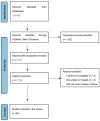Current Status of Protein Biomarkers in Urolithiasis-A Review of the Recent Literature
- PMID: 38002747
- PMCID: PMC10671847
- DOI: 10.3390/jcm12227135
Current Status of Protein Biomarkers in Urolithiasis-A Review of the Recent Literature
Abstract
Urolithiasis is an increasingly common clinical problem worldwide. The formation of stones is a combination of metabolic status, environmental factors, family history and many other aspects. It is important to find new ways to quickly detect and assess urolithiasis because it causes sudden, severe pain and often comes back. One way to do this is by exploring new biomarkers. Current advances in proteomic studies provide a great opportunity for breakthroughs in this field. This study focuses on protein biomarkers and their connection to kidney damage and inflammation during urolithiasis.
Keywords: children; protein biomarkers; urolithiasis.
Conflict of interest statement
The authors declare no conflict of interest, financial or otherwise.
Figures
References
-
- Tasian G.E., Ross M.E., Song L., Sas D.J., Keren R., Denburg M.R., Chu D.I., Copelovitch L., Saigal C.S., Furth S.L. Annual Incidence of Nephrolithiasis among Children and Adults in South Carolina from 1997 to 2012. Clin. J. Am. Soc. Nephrol. CJASN. 2016;11:488–496. doi: 10.2215/CJN.07610715. - DOI - PMC - PubMed
-
- Li Y., Bayne D., Wiener S., Ahn J., Stoller M., Chi T. Stone Formation in Patients Less than 20 Years of Age Is Associated with Higher Rates of Stone Recurrence: Results from the Registry for Stones of the Kidney and Ureter (ReSKU) J. Pediatr. Urol. 2020;16 doi: 10.1016/j.jpurol.2020.03.014. - DOI - PMC - PubMed
Publication types
LinkOut - more resources
Full Text Sources


